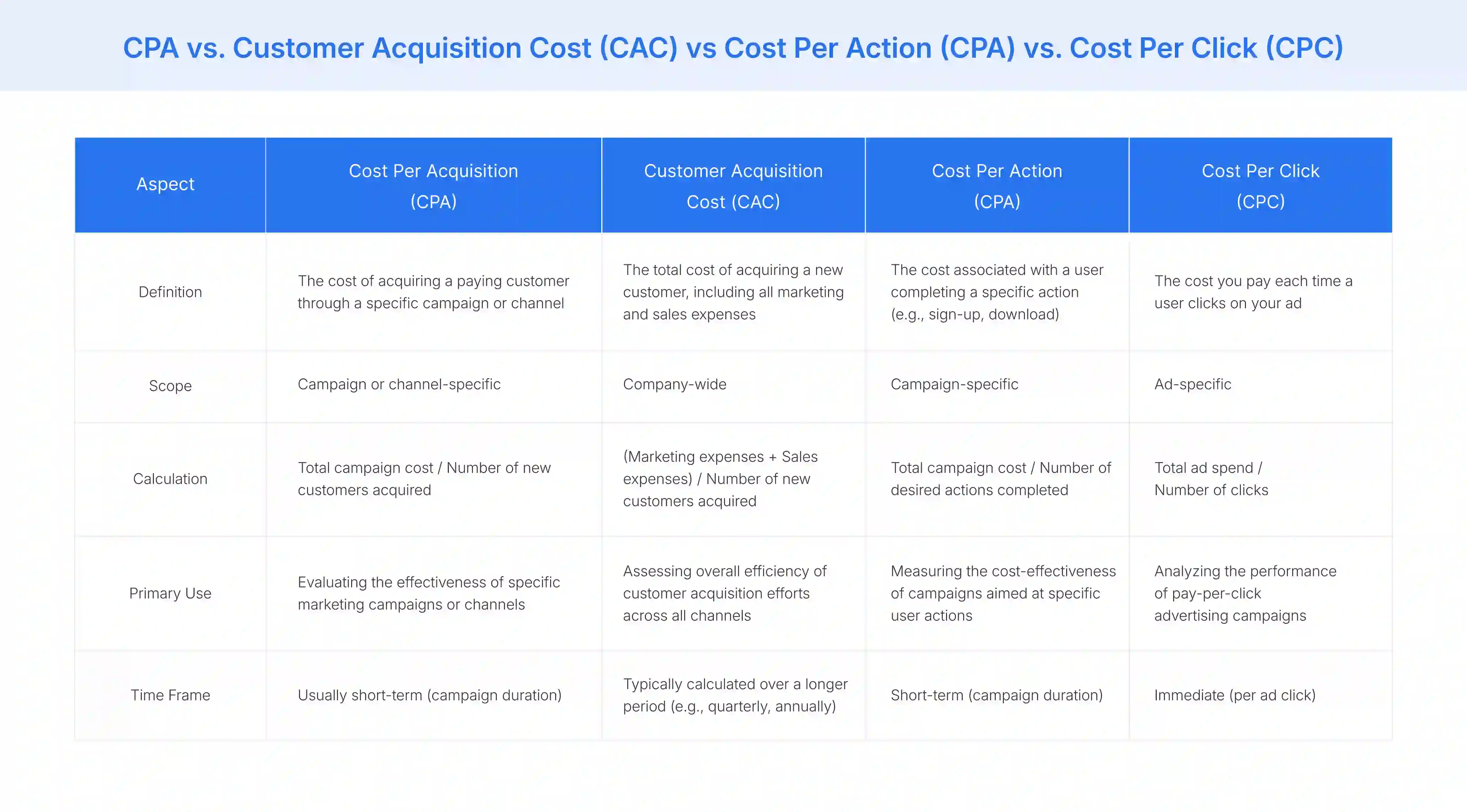Table of Contents
- What is Cost Per Acquisition (CPA)?
- Why is Cost Per Acquisition Important?
- How to Calculate Cost Per Acquisition?
- Factors Influencing Cost Per Acquisition
- Benefits and Challenges of Monitoring CPA
- Region-Specific Benchmarks for CPA
- Cost Per Acquisition vs. Related Metrics
- Conclusion
What is Cost Per Acquisition (CPA)?
Cost Per Acquisition (CPA) is a performance-based marketing metric used in digital marketing to measure the conversion costs involved in turning a prospect into a customer. It helps businesses understand how much they are spending to drive specific actions, such as purchases, sign-ups, or app downloads.
CPA is widely used across advertising platforms, including pay-per-click (PPC) campaigns like Google Ads, affiliate marketing, and social media marketing. Unlike general marketing spend, which focuses on brand awareness, CPA directly ties costs to measurable outcomes, making it a valuable indicator of campaign efficiency.
Businesses rely on CPA to evaluate the effectiveness of their advertising strategies. A well-optimized CPA is the best way to ensure profitability by balancing acquisition costs with customer lifetime value (LTV). The goal is to maintain a sustainable CPA while maximizing conversions, allowing for efficient budget allocation and improved return on investment (ROI).
Why is Cost Per Acquisition Important?
Cost Per Acquisition (CPA) is a crucial Key Performance Indicator (KPI) that helps businesses evaluate the efficiency of their marketing efforts. By tracking the CPA, you can determine the average cost of acquiring new customers and assess whether your ad campaign is delivering profitable results.
Effective budget allocation depends on monitoring CPA. A high CPA may indicate inefficiencies in targeting, ad creatives, or conversion strategies, while a lower CPA suggests cost-effective marketing execution. Understanding CPA enables you to refine advertising strategies, optimize spending, and focus on channels that generate the best return on investment (ROI).
CPA also plays a vital role in profitability assessment. By comparing CPA with Lifetime Value of a Customer(LTV), you can identify sustainable acquisition costs and adjust your pricing or content marketing approach accordingly. Businesses that consistently track and optimize CPA are better positioned to scale operations while maintaining profitability.
How to Calculate Cost Per Acquisition?
CPA calculation uses the following formula:

This calculation helps businesses assess how much they are spending per successful acquisition, enabling data-driven decision-making for marketing budget allocation.
For a more comprehensive analysis, calculate your CPA across different marketing channels, campaigns, or time periods. This will allow you to compare performance and identify the most cost-effective strategies for customer acquisition.
Let’s consider an example to understand the process better. Suppose your business spends $5,000 on a digital advertising campaign, which results in 250 customer purchases.
Applying the formula:
CPA = $5000 / 250 = $20
In this case, the cost per acquisition is $20 per customer, meaning you spend $20 to acquire each new paying customer. If you feel that your average CPA is too high, adjusting ad targeting, improving the number of conversions, or optimizing bidding strategies can help lower acquisition costs.
Factors Influencing Cost Per Acquisition
Here are the factors that directly impact your CPA:
- Industry Type: CPA differs across industries based on product pricing, competition, and customer buying behavior. High-ticket sectors like finance or SaaS often have a higher CPA than retail or FMCG.
- Target Audience: Demographics, interests, and online behavior influence CPA. Narrower audiences with higher purchasing power may increase acquisition costs, while broader audiences often lower CPA but may reduce conversion rates.
- Ad Placement & Platform: The channel you advertise on affects CPA. Paid search ads often have a higher CPA due to intent-driven traffic, whereas social media ads may provide lower acquisition costs through broader engagement.
- Market Competition: Industries with high competition experience increased bid prices for ad placements, driving up CPA. Competitor strategies also impact how much you must spend to stay competitive.
- Seasonality: Peak shopping seasons, such as holidays or Black Friday, often lead to higher CPAs due to increased advertiser competition. Off-season campaigns may have lower acquisition costs.
- Ad Quality & Relevance: A well-optimized ad with high engagement and relevance reduces CPA by improving Click-Through Rates (CTR) and lowering Cost-per-Click (CPC). Poorly optimized ads result in higher costs and lower conversions.
Benefits and Challenges of Monitoring CPA
While monitoring CPA provides valuable insights, relying solely on this metric can present certain challenges. Understanding both aspects ensures a balanced approach to marketing success.
Benefits
- Optimized Budget Allocation: Monitoring CPA helps you allocate marketing spend efficiently by identifying the most cost-effective channels. Lowering CPA ensures that you maximize conversions without overspending.
- Enhanced Campaign Performance: Analyzing CPA allows you to measure the effectiveness of different campaigns, refine targeting strategies, and adjust bidding tactics to improve overall marketing performance.
- Data-Driven Decision Making: Tracking CPA provides quantifiable insights, allowing you to make informed business decisions. By continuously monitoring trends, you can adjust strategies to maintain profitability and increase Return on Investment (ROI).
- Better Customer Acquisition Strategy: CPA analysis enables you to identify high-performing audience segments, refine messaging, and enhance ad creatives to attract more cost-effective conversions.
Challenges
- Overlooking Long-Term Value: Focusing exclusively on CPA may lead to neglecting Customer Lifetime Value (LTV). A lower CPA does not always indicate profitability if customer retention and repeat purchases are not considered.
- Misinterpreting Performance Metrics: CPA alone does not reflect the overall effectiveness of a marketing strategy. Ignoring engagement, conversion rates, and customer loyalty can lead to misinformed marketing decisions.
- Fluctuations Due to External Factors: Seasonality, competition, and market trends influence CPA. A sudden increase in CPA does not always indicate poor performance but may be due to industry-wide changes.
- Limited Perspective on Marketing Channels: Relying only on CPA can undervalue brand awareness and customer engagement efforts, which contribute indirectly to long-term revenue growth.
Region-Specific Benchmarks for CPA
CPA varies across regions due to differences in industry trends, consumer behavior, and advertising competition. Benchmarking your CPA against regional and industry-specific standards allows you to assess campaign efficiency and make data-driven adjustments to improve cost-effectiveness.
- Europe: CPA benchmarks fluctuate across industries. In France, for instance, the cost per acquisition for direct-to-consumer e-commerce brands ranged between €27.6 in the clothing and underwear sector and €35.6 in the homeware category in 2023. (Source)
- United States: CPA values in the US differ based on industry type and marketing channels. Businesses typically experience acquisition costs ranging from $21 to $377, with sectors such as finance and legal services reporting higher CPAs than retail or hospitality. (Source)
- Global Averages: On an international scale, e-commerce businesses generally report CPA values between $20 and $65. Factors such as audience demographics, advertising strategies, and seasonality influence these acquisition costs. (Source)
Cost Per Acquisition vs. Customer Acquisition Cost (CAC) vs CPA vs. Cost Per Click (CPC)
While all these metrics primarily focus on the aspects of customer acquisition costs, each provides unique insights:
- Cost Per Acquisition (CPA) focuses on the efficiency of specific campaigns in acquiring paying customers.
- Customer Acquisition Cost (CAC) gives a broader view of all costs involved in gaining new customers across your entire business.
- Cost Per Action (CPA) is versatile, measuring the cost of various desired user actions, not just purchases.
- Cost Per Click (CPC) is particularly useful for assessing the initial engagement of your paid advertising efforts.

Conclusion
CPA management is an ongoing process that requires vigilance, adaptability, and the right tools. By embracing solutions like those offered by Flipkart Commerce Cloud and maintaining a focus on continuous optimization, you can enhance your marketing efficiency and drive sustainable business growth in the competitive digital ecosystem.
About Flipkart Commerce Cloud
Flipkart Commerce Cloud provides cutting-edge retail technology solutions designed to help e-commerce businesses scale efficiently and enhance customer experiences. Our suite of solutions includes:
- ML-powered Pricing Tool for dynamic, ASIN-level pricing optimization
- Retail Media Platform that drives higher conversions through intent-driven ads
- Composable Digital Commerce Solution enabling businesses to build scalable, high-performing storefronts with AI-powered search and personalized recommendations.
Built by the technology experts behind India’s largest e-commerce platform, Flipkart, our team brings deep domain expertise in retail technology, coupled with a proven track record of solving complex e-commerce challenges at scale.
FAQ
CPA varies based on pricing models. Subscription-based models generally have higher CPAs but provide long-term revenue through recurring payments. One-time purchases may have lower CPAs but require consistent customer acquisition efforts. Evaluating customer lifetime value (LTV) alongside CPA ensures a sustainable marketing strategy for both models.
Businesses can monitor cost per acquisition using analytics platforms like Google Analytics, Facebook Ads Manager, and third-party attribution tools. Advanced solutions, such as Flipkart Commerce Cloud's Pricing Optimization Tool, help retailers track campaign performance, adjust pricing dynamically, and improve cost efficiency.
No, Cost Per Acquisition (CPA) varies across advertising channels due to differences in audience intent, competition, and conversion rates. Search ads typically have higher CPAs due to intent-driven clicks, while social media ads may offer lower acquisition costs through broader audience reach.

